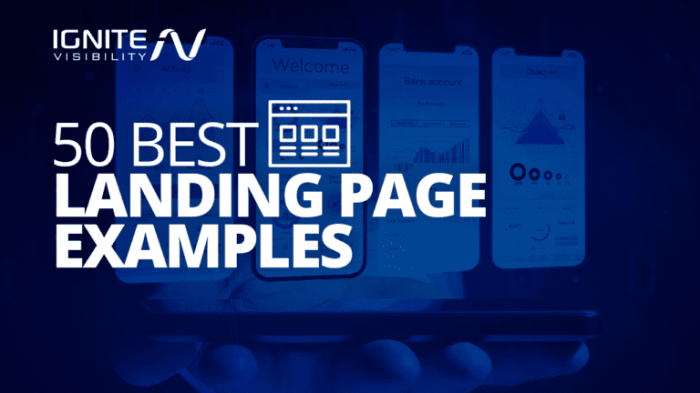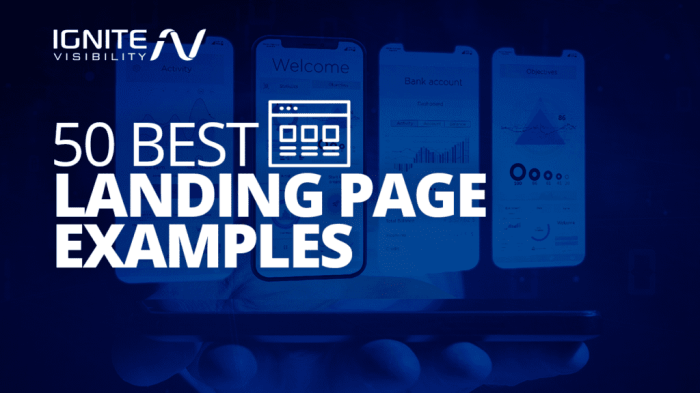Effective Landing Pages, where style meets substance in the digital realm, are the secret sauce to skyrocketing your online presence and engagement. From captivating headlines to irresistible call-to-action buttons, buckle up for a ride into the world of conversion optimization.
Ready to dive deep into the art of crafting the perfect landing page? Let’s explore the key elements and design practices that will take your online campaigns to the next level.
Importance of Effective Landing Pages

Landing pages play a crucial role in online marketing campaigns as they serve as the first point of contact between a user and a website. These pages are specifically designed to convert visitors into leads or customers by providing them with relevant information and enticing offers.
Effective landing pages can significantly increase conversion rates by guiding users towards taking a specific action, such as signing up for a newsletter, downloading a free resource, or making a purchase. By focusing on a single objective and eliminating distractions, well-designed landing pages can streamline the user experience and encourage desired outcomes.
Impact of a Well-Designed Landing Page on User Engagement
A well-designed landing page can enhance user engagement by delivering a seamless and personalized experience. Through compelling visuals, persuasive copy, and clear call-to-action buttons, a landing page can capture the user’s attention and motivate them to explore further.
- Engaging Visuals: High-quality images and videos can create a visually appealing environment that keeps users interested and encourages them to stay on the page longer.
- Compelling Copy: Persuasive language that highlights the benefits of a product or service can resonate with users and persuade them to take action.
- Clear Call-to-Action: A prominent and easy-to-find call-to-action button directs users on what steps to take next, simplifying the decision-making process and driving conversions.
Elements of High-Converting Landing Pages
When it comes to creating landing pages that convert visitors into customers, there are several key elements that play a crucial role in determining the success of your campaign. From clear call-to-action buttons to compelling headlines and persuasive copy, each component has its own significance in driving conversions and maximizing the effectiveness of your landing page.
Clear Call-to-Action Buttons
One of the most important elements of a high-converting landing page is a clear and prominent call-to-action button. This button should be strategically placed on the page and stand out visually to attract the attention of visitors. The language used on the button should be action-oriented and clearly communicate what action the visitor is expected to take next, whether it’s signing up for a newsletter, requesting a demo, or making a purchase. A well-designed call-to-action button can significantly increase the conversion rate of your landing page.
Compelling Headlines and Persuasive Copy
Another essential element of a high-converting landing page is a compelling headline that grabs the attention of visitors and entices them to keep reading. Your headline should be clear, concise, and relevant to the offer or product you are promoting. In addition to a strong headline, persuasive copy is also crucial in convincing visitors to take the desired action. Your copy should highlight the benefits of your offer, address the pain points of your target audience, and create a sense of urgency to encourage immediate action. By combining a compelling headline with persuasive copy, you can effectively communicate the value of your offer and persuade visitors to convert.
Design Best Practices for Landing Pages

When it comes to creating effective landing pages, design plays a crucial role in capturing the attention of your audience and encouraging them to take action. Here are some tips for designing visually appealing landing pages that convert:
Significance of Mobile Responsiveness
In today’s digital age, mobile responsiveness is non-negotiable when it comes to landing page design. With the majority of users accessing websites on their smartphones and tablets, it’s essential to ensure that your landing page looks and functions seamlessly across all devices. A responsive design not only enhances the user experience but also improves your page’s chances of ranking higher in search engine results.
Effective Color Schemes and Typography Choices, Effective Landing Pages
The colors and typography you choose for your landing page can significantly impact its overall effectiveness. Opt for a color scheme that aligns with your brand and evokes the right emotions in your audience. Use contrasting colors to make important elements stand out, such as call-to-action buttons. When it comes to typography, make sure your text is easy to read and complements the overall design of your page. Experiment with different fonts, sizes, and styles to find the perfect combination that enhances readability and visual appeal.
A/B Testing and Optimization
A/B testing is crucial in optimizing landing page performance as it allows you to compare two versions of a page to determine which one performs better in terms of conversion rates. By testing different elements such as headlines, images, call-to-action buttons, and overall layout, you can gather valuable data to make informed decisions for improving your landing page.
Analyzing A/B Test Results
After conducting A/B tests, it’s essential to analyze the results carefully to understand which version of the landing page resonates better with your audience. Some methods for analyzing A/B test results include:
- Comparing conversion rates: Look at which version of the page resulted in a higher conversion rate to determine the most effective elements.
- Analyzing engagement metrics: Evaluate metrics such as bounce rate, time on page, and click-through rate to gain insights into user behavior.
- Segmenting data: Break down the results by different segments (such as demographics or traffic sources) to identify patterns and preferences.
Continuous Optimization for Improved Conversion Rates
Continuous optimization involves making ongoing improvements to your landing page based on the insights gathered from A/B testing. By implementing data-driven decisions and refining elements that have proven to drive conversions, you can steadily increase your conversion rates over time. Remember, optimization is a never-ending process that requires constant monitoring and tweaking to ensure your landing page is performing at its best.





